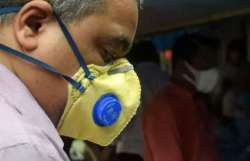Study shows why masks with exhalation valves do not slow COVID-19 spread
Scientists have used high-speed videos of air flow to show why masks with exhalation valves do not slow the spread of COVID-19.

Scientists have used high-speed videos of air flow to show why masks with exhalation valves do not slow the spread of COVID-19. The researchers from National Institute of Standards and Technology (NIST) in the US created the videos which show airflow patterns through masks with and without exhalation valves.
"When you compare the videos side by side, the difference is striking," said NIST research engineer Matthew Staymates, corresponding author of the study published in the journal Physics of Fluids.
"These videos show how the valves allow air to leave the mask without filtering it, which defeats the purpose of the mask," Staymates said.
Exhalation valves, which make masks easier to breathe through and more comfortable, are appropriate when the mask is meant to protect the wearer, the researchers said.
For instance, valved masks can protect workers from dust at a construction site or hospital workers from infected patients, they said.
Staymates created two videos using different flow visualisation techniques. The first video was created using what is known as a schlieren imaging system, which causes differences in air density to show up on camera as patterns of shadow and light.
With this system, exhaled breath becomes visible because it is warmer, and therefore less dense, than the surrounding air.
Staymates created the second video using a light-scattering technique.
He built an apparatus that emits air at the same velocity and tempo as a resting adult, then connected that device to a mannequin.
As a stand-in for exhaled droplets, the air carries water droplets in a range of sizes typical of the droplets that people emit in their breath when exhaling, speaking and coughing.
A high-intensity LED light behind the mannequin illuminates the airborne droplets, causing them to scatter the light and show up brightly on camera.
In contrast to the schlieren video, this video shows the movement of droplets in air. The droplets escape unfiltered through the valve of an N95 mask.
The use of a mannequin and a mechanical breathing apparatus allowed Staymates to observe airflow patterns while holding steady the breathing rate, air pressure and other variables.